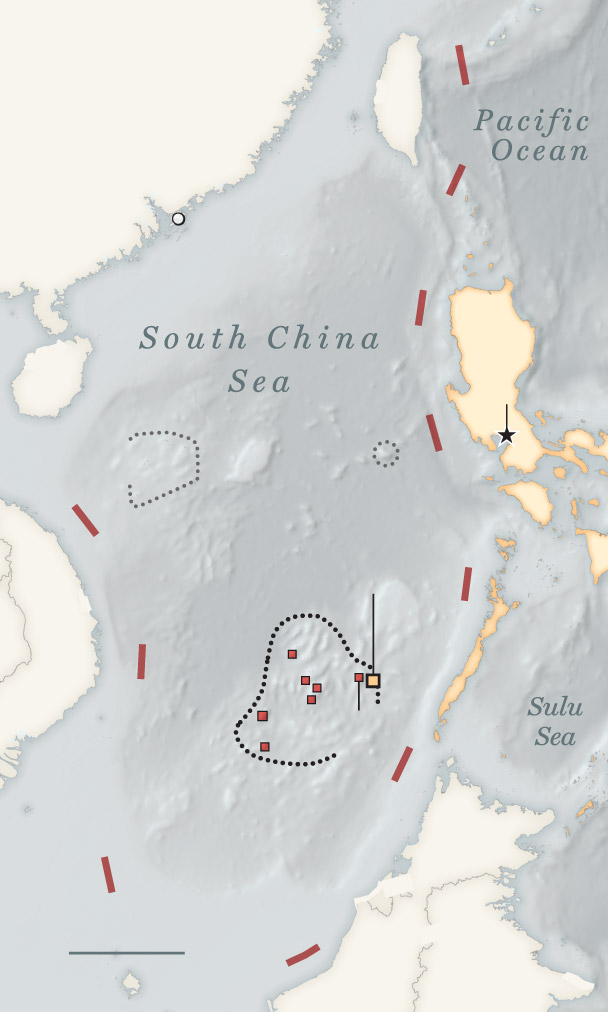MANILA — The Chinese coast guard boarded Philippine navy vessels and damaged and confiscated equipment in a confrontation that left a sailor severely injured earlier this week, the Philippines announced Wednesday, in a stark escalation of tensions over the highly contested South China Sea.
World
Philippines says sailor lost finger in sea clash, accuses China of ‘piracy’

Chinese coast guard used knives and machetes to puncture Philippine rubber dinghies that were attempting to reach the outpost and confiscated equipment aboard the navy vessels, including the mobile phones of sailors. A Philippine sailor lost a finger when a Chinese dinghy collided with a Philippine dinghy at high speed, hitting his hand that was caught in between the two vessels, officials said.
10-dash line
China’s maritime claims
Seven islands
occupied by China
within the
Spratly Island
chain

China’s maritime claims
Seven islands
occupied by
China within the
Spratly Island
chain

China’s maritime claims
Seven islands
occupied by
China within the
Spratly Island
chain
At least seven other Philippine sailors were also injured. Chinese ships later towed away two Philippine rubber dinghies after emptying them of their contents, Philippine officials said.
GET CAUGHT UP
Stories to keep you informed
“This is piracy,” Gen. Romeo Brawner Jr., the Philippine armed forces’ chief of staff, said in a news conference held in Palawan, an island province 120 miles from the reef. “They boarded our boats illegally, they took our equipment. They are like pirates with the actions they carried out.” Brawner added that the Philippine navy personnel “fought back” but were significantly outnumbered by the Chinese and chose not to employ weapons.
“Our objective is that while we want to bring supplies to our troops following international laws, our objective is also to prevent war. We do not want a war,” he said.
At a news briefing Wednesday, Chinese Foreign Ministry spokesman Lin Jian blamed the Philippines for the confrontation and claimed that the Philippine vessels were carrying construction materials and weapons as part of a long-term occupation of the Second Thomas Shoal, which China opposes. “The China Coast Guard took professional and restrained enforcement measures,” Lin Jian said, adding the Chinese forces “did not take direct measures against Philippine personnel.”
Earlier this week, Gan Yu, a spokesman for the Chinese Coast Guard said the Philippine resupply ships “deliberately and dangerously” approached a Chinese ship, resulting in a collision.
China has sought to dominate the South China Sea, a strategic waterway that is also claimed in part by six other governments. Backed by the United States, the Philippines has been ramping up its efforts to push back against the Chinese but is being met with an increasingly forceful response from Beijing that security analysts say could spur broader conflict in the Pacific.
Nowhere is the situation more precarious than at Second Thomas Shoal, said Zack Cooper, a senior fellow at the American Enterprise Institute, where he studies U.S. strategy in Asia. The shoal is one of the only locations where Chinese and Philippine forces are contesting control over physical territory. The Philippines in 1999 beached the Sierra Madre on the shoal and has since populated it with a contingent of marines to create a human presence and stake its claim to the reef.
“It’s the most problematic area in terms of leading to a real, genuine conflict,” Cooper said. What happened on Monday was “very serious,” he added, and would probably lead to calls for the United States to intervene.
The United States shares a mutual defense treaty with the Philippines and Biden administration officials have stressed in recent months that an armed attack on Philippine military vessels or personnel in the South China Sea would trigger a U.S. military response. The U.S. ambassador to the Philippines, MaryKay Carlson, on Tuesday condemned China’s “aggressive, dangerous maneuvers” at the Sierra Madre but did not say whether or how the United States would respond. A spokesman for the U.S. Embassy in Manila declined to answer questions on a U.S. response.
Earlier this month, President Ferdinand Marcos Jr. said at a security summit in Singapore that the death of a Filipino citizen through a “willful act” would be “close to an act of war” that could prompt a military response. “Our treaty partner holds that same standard,” he said, referring to the United States.
But the Philippines also has to be wary of when to call upon the United States, said Julio Amador, a Manila-based security analyst. The Philippines has been accused by Beijing of being a “pawn” of the United States, a charge top Philippine officials have rejected. Conducting the resupply mission to Second Thomas Shoal in the face of an imposing Chinese presence is a “an exercise of agency” for the Philippines, said Amador. The government “wants to be able to do this without having to ask for help,” he said.
No Philippine vessels were able to reach the Sierra Madre on Monday to provide supplies for the troops stationed on board, but the navy will try again, said Brawner. “We will defend our rights and we will fight for our future,” he said.
Ship-tracking data showed that as of Wednesday afternoon, dozens of Chinese ships continued to surround Second Thomas Shoal. A 12,000-ton Chinese coast guard vessel, probably the largest of its kind in the world, was also sailing toward to the Philippine island of Thitu near the vicinity of Second Thomas, said Ray Powell, an analyst at Stanford University’s Gordian Knot Center for National Security Innovation.
Tan reported from Singapore. Lyric Li contributed reporting from Seoul.







:max_bytes(150000):strip_icc()/roundup-writereditor-loved-deals-tout-f5de51f85de145b2b1eb99cdb7b6cb84.jpg)


